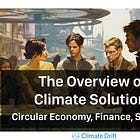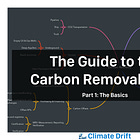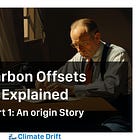The Overview of Climate Solutions
Food & Agriculture, Carbon Removal & Offsets and Protecting Nature
Welcome to Climate Drift, where we demystify climate solutions and empower you to find your distinct role in the race to net zero.
If you haven't joined our community yet, subscribe here:
Hey there 👋
Skander, here!
Welcome to Part 3 of our series where we dive into solution maps across 12 areas, ranging from Energy to Circular Economy and Transportation.
Today we dive into Food & Agriculture, Carbon Removal & Offsets and Protecting Nature.
In Part 1 we look into our solutions map for the Industry, Built Environment, and Workforce sectors.
Part 2 offers insights into our solutions map for the Climate Finance, the Circular Economy and Software-First Solutions.
For each map, I've provided a concise overview, targeting around 200 words for brevity.
Let’s dive in 🌊
Food & Agriculture
To sustainably feed an estimated 10 billion people by 2050, our global food system must undergo significant transformation. This entails not only meeting the demand without expanding agricultural land or harming biodiversity but also drastically reducing greenhouse gas (GHG) emissions.
Several critical Food & Agriculture areas need urgent solutions:
Agricultural Practices: We must halt agricultural land expansion and focus on sustainably increasing crop yields. Between 2015 and 2019, direct emissions from agriculture rose by 2%. While this is a modest increase, it highlights the urgency for substantial changes to meet 2030 and 2050 emission reduction targets. The growth in crop yields must quicken sixfold in the next decade.
Ruminant Meat Consumption: High-income countries need to reduce their ruminant meat (beef, lamb, and goat) intake significantly. Thankfully we have a wide range of alternative proteins at our disposal. We also need to ensure that any remaining consumption is met through efficient means, like enhancing feed efficiency and pasture productivity.
Tackling Food Waste: Globally, 14% of food is lost between production and processing, while an additional 17% is wasted at the consumption level (UNEP, 2021d). Addressing this inefficiency requires a full new batch of solutions.
Carbon Removal & Offsets
Simply reducing emissions across all value chains, while important, will not suffice. To truly combat rising global temperatures and counteract the decades of greenhouse gases we have already released into the atmosphere, we must also actively remove existing emissions. In addition, offsetting provides another avenue to help balance the carbon ledger.
Carbon removal techniques, on the left side of the map, such as afforestation, bioenergy with carbon capture and storage (BECCS), and direct air capture, offer promising solutions. These methods aim to extract carbon dioxide directly from the atmosphere and either store it safely or repurpose it.
To learn more about Carbon Removal check out our Guide to the Carbon Removal Hype
On the other hand, carbon offsets are essentially investments in projects that reduce or remove greenhouse gas emissions, allowing entities to compensate for their emissions. Whether it's by supporting wind farms, reforestation projects, or innovative green technologies, offsets can play a role in closing the gap between actual emissions and emission reduction targets.
To learn more about Carbon Offsets check out our Offset Explainer Series
Protecting Nature
To limit global temperature rise to 1.5°C, immediate action is required to preserve and sustainably manage natural carbon sinks like forests, peatlands, and mangroves. These measures could mitigate up to 7.3 GtCO2e annually from 2020 to 2050 at cost-effective rates. However, current efforts are lacking. In 2019, CO2 emissions from land-use changes made up approximately 11% of global GHG emissions. Halting deforestation, peatland degradation, and mangrove loss are essential for climate action, given these ecosystems hold over 1,020 gigatonnes of carbon. Once disrupted, the carbon released from these ecosystems is challenging to reclaim.
Recent trends show more discouraging progress: deforestation across an area larger than Norway occurred between 2015-2021, with significant losses in carbon-rich primary forests. Mangrove losses are also on the rise, while peatlands in Southeast Asia are being drained for agriculture. Large-scale commodity production, driven by demand from wealthier nations, is a significant deforestation contributor. A collaborative approach, involving governments, financial institutions, companies, and civil society, is needed.
To dive into our current state and goals I highly recommend this explainer:
https://www.carbonbrief.org/explainer-can-the-world-halt-and-reverse-biodiversity-loss-by-2030/
As we've explored in this series so far, solutions span from reshaping our food systems, to actively removing and offsetting carbon emissions, and protecting the natural carbon sinks of our world. What's clear is that no single effort is enough on its own; we must approach this with a holistic mindset.
Tomorrow in the last part of this series we will look at Water, Power and Transportation.
Looking forward,
Skander
PS: Want to help out? Share this post with anyone you believe would appreciate it.












